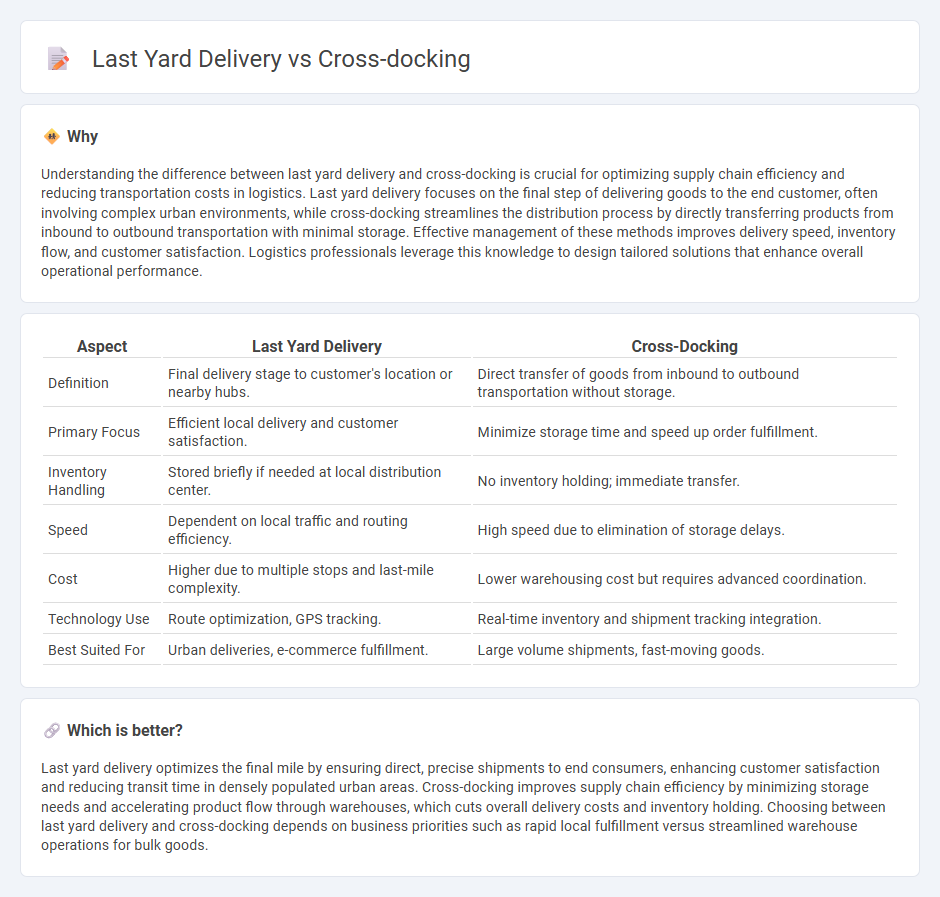
Last yard delivery focuses on transporting goods from a local distribution center directly to the customer's doorstep, optimizing speed and personalized service for urban and suburban areas. Cross-docking streamlines the supply chain by transferring products directly from inbound to outbound transportation with minimal storage, reducing inventory costs and accelerating delivery times. Explore more to understand which logistics strategy best enhances efficiency and customer satisfaction.
Why it is important
Understanding the difference between last yard delivery and cross-docking is crucial for optimizing supply chain efficiency and reducing transportation costs in logistics. Last yard delivery focuses on the final step of delivering goods to the end customer, often involving complex urban environments, while cross-docking streamlines the distribution process by directly transferring products from inbound to outbound transportation with minimal storage. Effective management of these methods improves delivery speed, inventory flow, and customer satisfaction. Logistics professionals leverage this knowledge to design tailored solutions that enhance overall operational performance.
Comparison Table
| Aspect | Last Yard Delivery | Cross-Docking |
|---|---|---|
| Definition | Final delivery stage to customer's location or nearby hubs. | Direct transfer of goods from inbound to outbound transportation without storage. |
| Primary Focus | Efficient local delivery and customer satisfaction. | Minimize storage time and speed up order fulfillment. |
| Inventory Handling | Stored briefly if needed at local distribution center. | No inventory holding; immediate transfer. |
| Speed | Dependent on local traffic and routing efficiency. | High speed due to elimination of storage delays. |
| Cost | Higher due to multiple stops and last-mile complexity. | Lower warehousing cost but requires advanced coordination. |
| Technology Use | Route optimization, GPS tracking. | Real-time inventory and shipment tracking integration. |
| Best Suited For | Urban deliveries, e-commerce fulfillment. | Large volume shipments, fast-moving goods. |
Which is better?
Last yard delivery optimizes the final mile by ensuring direct, precise shipments to end consumers, enhancing customer satisfaction and reducing transit time in densely populated urban areas. Cross-docking improves supply chain efficiency by minimizing storage needs and accelerating product flow through warehouses, which cuts overall delivery costs and inventory holding. Choosing between last yard delivery and cross-docking depends on business priorities such as rapid local fulfillment versus streamlined warehouse operations for bulk goods.
Connection
Last yard delivery optimizes the final stage of the supply chain by ensuring goods reach customers efficiently, while cross-docking minimizes storage time by transferring products directly between inbound and outbound shipments. Integrating cross-docking with last yard delivery streamlines inventory flow and reduces transportation costs. This connection enhances overall logistics performance by accelerating delivery times and improving resource utilization.
Key Terms
Transshipment
Cross-docking streamlines transshipment by rapidly transferring goods between inbound and outbound transportation without long-term storage, minimizing warehouse costs and reducing delivery times. Last yard delivery, as the final stage in the logistics chain, focuses on efficiently moving products from local hubs to the customer's doorstep, ensuring timely and accurate shipments. Explore the key differences and benefits to optimize your supply chain operations.
Consolidation
Cross-docking streamlines consolidation by transferring goods directly from inbound to outbound transportation with minimal storage, enhancing efficiency and reducing handling costs. Last yard delivery emphasizes consolidation by grouping multiple delivery orders to the final destination, improving route optimization and customer satisfaction. Explore more insights on optimizing logistics consolidation strategies for your supply chain.
Final-mile
Cross-docking streamlines final-mile delivery by minimizing storage time and accelerating the transfer of goods from inbound to outbound transportation, enhancing supply chain efficiency. Last yard delivery concentrates on the critical final segment, ensuring packages reach the customer's doorstep with accuracy and speed, often involving specialized solutions like parcel lockers or local couriers. Explore more about optimizing final-mile logistics for improved customer satisfaction and reduced operational costs.
Source and External Links
Cross Docking: Definition, History, and Process - Cross-docking is a shipping method that transfers goods directly from one transportation mode to another with minimal storage, including continuous, consolidation, and deconsolidation methods to optimize flow and reduce costs.
What Is Cross-Docking? Definition, Types & Advantages - Cross-docking is a supply chain strategy involving direct transfer of goods from inbound to outbound vehicles at a logistics facility to speed delivery, reduce costs, and minimize warehouse storage.
Understanding cross-docking: A comprehensive guide - Cross-docking is a logistics process where goods are transferred quickly from inbound suppliers to outbound customers with little or no storage, categorized by timing (pre- vs. post-distribution) and process type (continuous, consolidation, deconsolidation), with applications in retail, manufacturing, and e-commerce.
 dowidth.com
dowidth.com